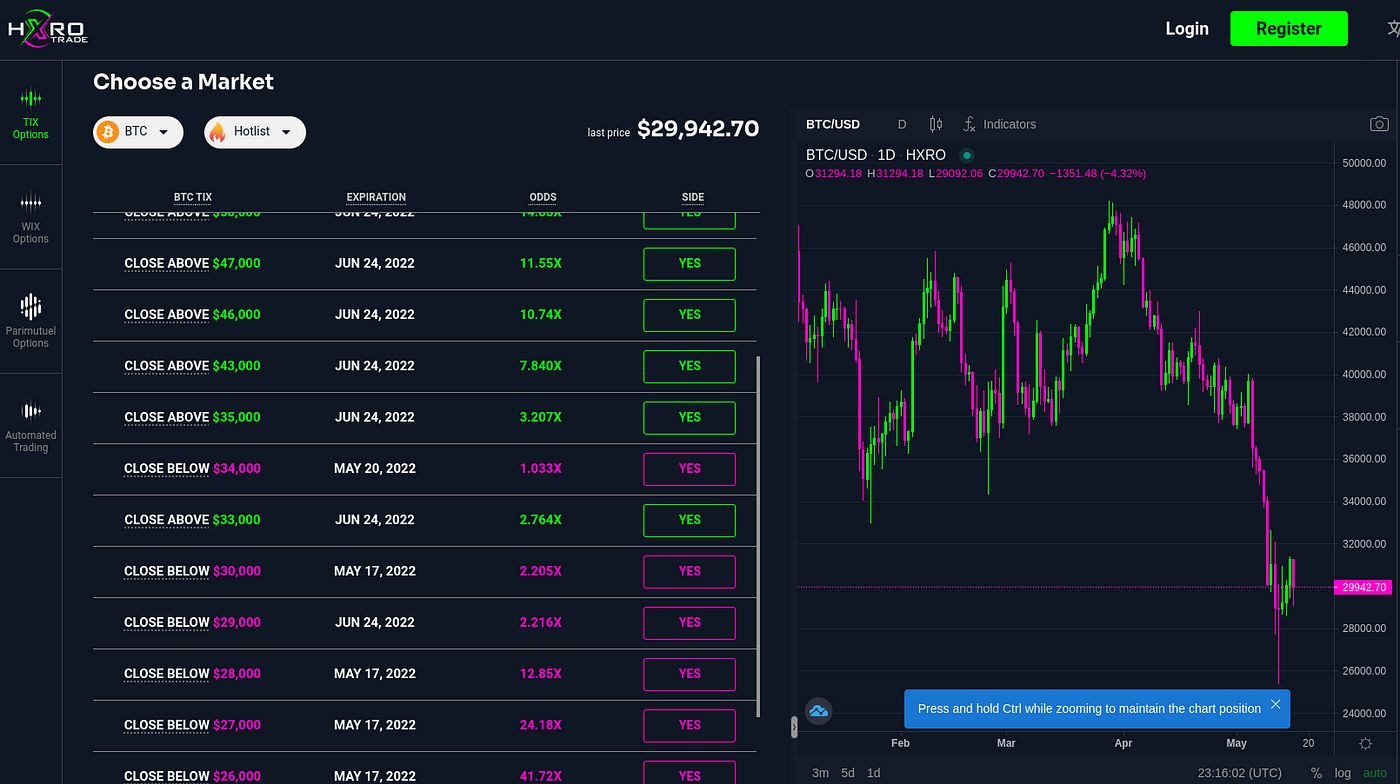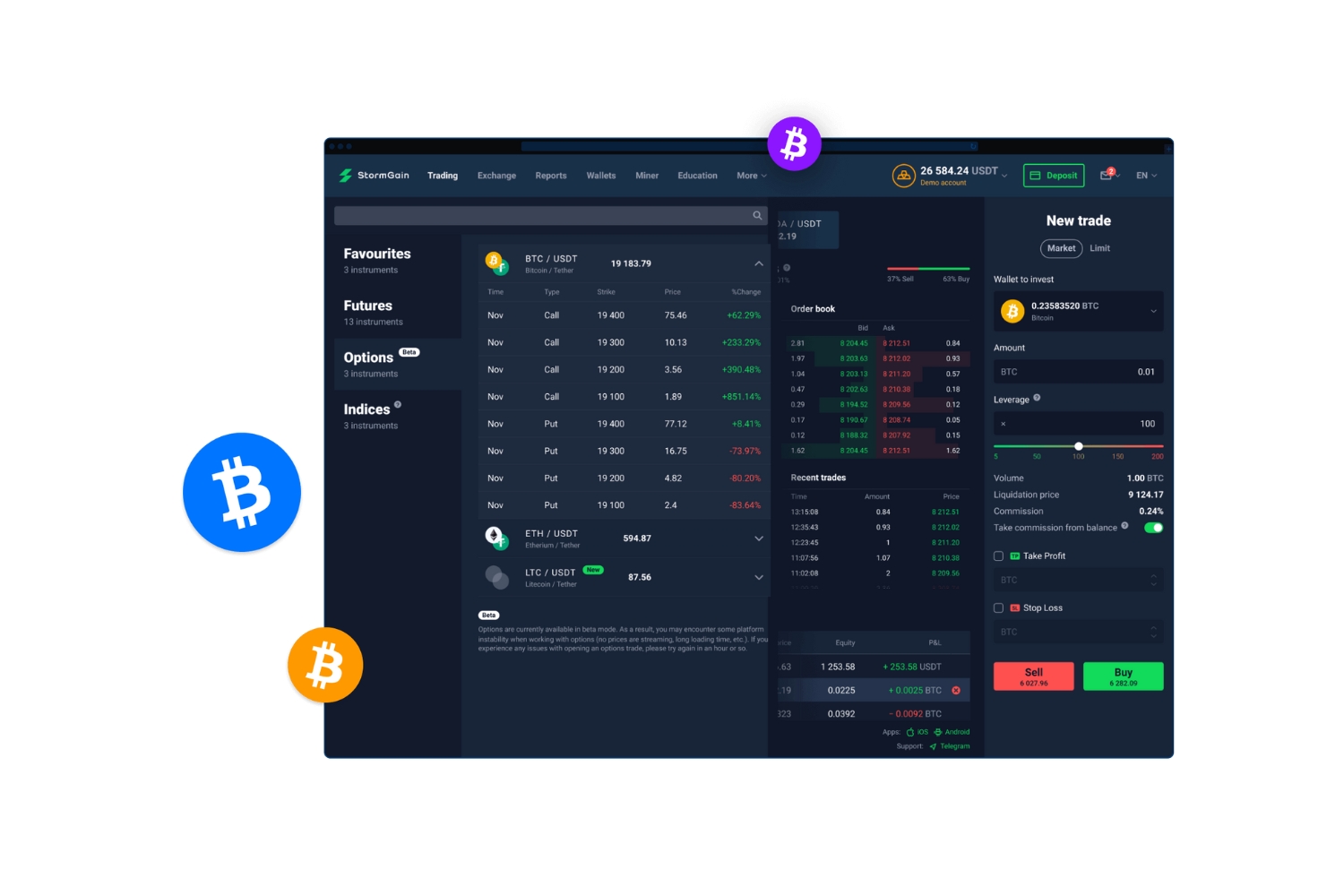Introduction
Option trading is a popular and dynamic investment strategy that provides traders with the opportunity to profit from market fluctuations. It involves the buying and selling of options contracts, which give the holder the right, but not the obligation, to buy or sell an underlying asset at a predetermined price within a specific timeframe.
Unlike traditional stock trading, where investors buy or sell shares of a company, option trading allows for more flexibility and versatility. It can be used as a standalone trading strategy or as a complement to other investment approaches.
In the ever-changing world of financial markets, option trading has gained significant traction due to its potential for generating substantial returns. However, it is crucial to understand the intricacies of options and the associated risks before diving into this complex trading arena.
Options offer traders various strategies for profit generation, including hedging against potential losses and capitalizing on market volatility. With the right knowledge and skills, options can be a powerful tool in a trader’s arsenal.
This article aims to provide a comprehensive overview of option trading, covering the key concepts, types of options, pricing factors, trading strategies, risks, and rewards. Whether you are a novice trader exploring new investment avenues or an experienced investor looking to diversify your portfolio, this guide will equip you with the essential knowledge to navigate the world of option trading.
So, let’s embark on this thrilling journey into the realm of options and discover the potential it holds for your financial goals.
Overview of Option Trading
Option trading is a financial derivative that grants traders the right, but not the obligation, to buy or sell an underlying asset at a predetermined price, known as the strike price, within a specific timeframe. This type of trading provides traders with the flexibility to profit from market movements without actually owning the underlying asset.
Options can be bought and sold on various securities, including stocks, indices, commodities, and currencies. The primary goal of option trading is to anticipate the direction in which the price of the underlying asset will move and capitalize on those movements.
One of the key advantages of option trading is leverage. Since options allow traders to control a large number of shares with a relatively small investment, they offer the potential for significant returns. This leverage also amplifies the risk, as losses can occur quickly if market movements are unfavorable.
There are two types of options: call options and put options. A call option gives the holder the right to buy the underlying asset at the strike price, while a put option gives the holder the right to sell the underlying asset at the strike price. Traders can use these options to speculate on both rising and falling markets, depending on their expectations.
Options also have expiration dates, which determine the timeframe within which the holder can exercise their rights. These expiration dates can range from days to months or even years, allowing traders to choose the time horizon that best suits their trading strategy.
Option trading relies on the concept of intrinsic value and time value. Intrinsic value is the difference between the current price of the underlying asset and the strike price, while time value represents the potential for future price movements. These factors determine the overall price of an option.
Option trading strategies can range from simple to complex, depending on the trader’s objectives and risk tolerance. Some common strategies include buying call options to profit from upward price movements, buying put options to profit from downward price movements, and writing covered calls or cash-secured puts to generate income.
It is important to note that option trading involves risks, and traders should carefully assess their risk tolerance and investment goals before entering the market. However, with proper education, risk management strategies, and disciplined trading practices, option trading can be a rewarding and lucrative venture.
In the next section, we will delve deeper into the concepts and intricacies of options, providing a comprehensive understanding of how they work and the factors that affect their prices.
Understanding Options
Options are financial contracts that give traders the right, but not the obligation, to buy or sell an underlying asset at a predetermined price within a specific timeframe. They provide traders with the opportunity to profit from market movements without actually owning the underlying asset.
When trading options, it is essential to understand key terminologies. The buyer of an option is known as the holder, while the seller is referred to as the writer. The predetermined price at which the underlying asset can be bought or sold is called the strike price.
There are two types of options: call options and put options. A call option gives the holder the right to buy the underlying asset at the strike price, while a put option gives the holder the right to sell the underlying asset at the strike price. These options can be bought and sold on various securities, including stocks, indices, commodities, and currencies.
Options also have expiration dates, which determine the timeframe within which the holder can exercise their rights. European-style options can only be exercised on the expiration date, while American-style options can be exercised at any time before the expiration date.
It is important to note that options have a cost associated with them, known as the premium. The premium is influenced by several factors, including the current price of the underlying asset, the strike price, the time remaining until expiration, and the volatility of the underlying asset.
Options provide traders with distinct advantages. For buyers, options offer limited risk, as they only stand to lose the premium paid for the option. Buyers also have the opportunity for unlimited profit potential if the underlying asset moves in the expected direction.
On the other hand, option writers face unlimited risk, as they are obligated to fulfill the terms of the contract if the holder decides to exercise their rights. However, writers earn the premium collected from selling the option, which can serve as a source of income.
Traders use options for various purposes, including speculation, hedging, and income generation. Speculators aim to profit from market movements by buying options that align with their predictions. Hedgers, on the other hand, use options to protect their portfolios from potential losses by offsetting risks associated with the underlying assets. In addition, options can be employed as income-generating strategies by writing covered calls or cash-secured puts.
Understanding the fundamentals of options is crucial before delving into advanced trading strategies. By grasping the concepts of call options, put options, expiration dates, premiums, and the potential risks, traders can effectively utilize options as a valuable tool in their investment arsenal.
In the next section, we will explore the different types of options available and how they can be utilized in trading strategies to generate profits.
Types of Options
Options come in various forms, each serving different purposes and catering to the specific needs of traders. Understanding the different types of options is crucial for constructing effective trading strategies and managing risk. Let’s explore some of the most common types of options:
- Call Options: Call options give the holder the right, but not the obligation, to buy the underlying asset at the strike price before the expiration date. Call options are typically used when traders expect the price of the underlying asset to rise. By purchasing a call option, traders can capitalize on the potential upside movement of the asset while limiting their risk to the premium paid.
- Put Options: Put options, on the other hand, give the holder the right, but not the obligation, to sell the underlying asset at the strike price before the expiration date. Put options are commonly used to profit from falling prices or to protect existing positions from potential downside risks. By purchasing a put option, traders can potentially profit from a decline in the price of the underlying asset while limiting their risk to the premium paid.
- Stock Options: Stock options are options contracts based on individual stocks. They give traders the ability to buy or sell a specific number of shares of a particular stock at the strike price. Stock options are widely traded and offer ample opportunities for profit generation and risk management.
- Index Options: Index options are options contracts based on market indices, such as the S&P 500 or the NASDAQ 100. Index options provide traders with exposure to a basket of stocks rather than just a single stock. Trading index options allows traders to capitalize on broad market movements without the need to select individual stocks.
- Exchange-Traded Options: Exchange-traded options are standardized options contracts traded on regulated exchanges. These options have predetermined contract specifications, including the underlying asset, expiration date, and strike price. The standardized nature of exchange-traded options makes them highly liquid and easily tradable.
- Over-the-Counter Options: Over-the-counter (OTC) options are customizable options contracts negotiated between two parties outside of an exchange. OTC options offer more flexibility in terms of contract terms and can be tailored to fit specific trading requirements. However, OTC options are typically less liquid and have higher counterparty risks compared to exchange-traded options.
These are just a few examples of the many types of options available in the market. Each type has its own unique characteristics and advantages. By understanding the different types of options, traders can select the most suitable contracts for their trading strategies and risk preferences.
In the next section, we will delve into the pricing of options and the various factors that influence their prices.
Call Options
Call options are a type of options contract that give the holder the right, but not the obligation, to buy an underlying asset at a specified price, known as the strike price, within a specific period of time. Call options are commonly used by traders who anticipate that the price of the underlying asset will rise.
When a trader purchases a call option, they pay a premium to the option seller. This premium represents the cost of acquiring the right to buy the underlying asset. The strike price determines the price at which the asset can be purchased if the call option is exercised.
The profit potential for call options is unlimited. If the price of the underlying asset rises above the strike price, the holder can exercise the call option and buy the asset at a lower price, subsequently selling it at the higher market price for a profit. However, if the price of the underlying asset does not exceed the strike price before the expiration date, the call option will expire worthless, and the holder will lose the premium paid.
Call options offer several advantages to traders. Firstly, they provide the opportunity to control a larger position in the market with a relatively smaller investment, thanks to the leverage provided by options. This amplifies profit potential. Additionally, call options provide traders with a way to participate in upward market movements while limiting potential losses to the premium paid.
Traders employ various strategies when trading call options. One common strategy is buying call options outright, known as long calls. This strategy is suitable for traders who believe the price of the underlying asset will increase significantly within a specific timeframe. By purchasing call options, traders can potentially benefit from the price appreciation of the underlying asset without having to invest a substantial amount of capital.
Another strategy involving call options is the covered call strategy. In this strategy, traders who already own the underlying asset sell call options against their stock holdings. By doing so, they earn income from the premiums received, which can offset potential losses if the price of the underlying asset does not rise above the strike price.
It is important to note that trading call options involves risks. If the market moves unfavorably and the price of the underlying asset declines, the call option may expire worthless, resulting in a loss of the premium paid. Traders should carefully assess their risk tolerance and have a clear understanding of their trading objectives before engaging in call option trading.
Understanding the nuances of call options is essential for traders looking to leverage upward market movements and profit from their predictions. By utilizing call options effectively and implementing appropriate risk management strategies, traders can potentially enhance their investment returns and diversify their trading portfolio.
In the next section, we will explore the concept of put options and how they can be utilized in various trading strategies.
Put Options
Put options are a type of options contract that give the holder the right, but not the obligation, to sell an underlying asset at a specified price, known as the strike price, within a specific period of time. Put options are commonly used by traders who anticipate that the price of the underlying asset will decline.
When a trader purchases a put option, they pay a premium to the option seller. This premium represents the cost of acquiring the right to sell the underlying asset. The strike price determines the price at which the asset can be sold if the put option is exercised.
The profit potential for put options is significant. If the price of the underlying asset falls below the strike price, the holder can exercise the put option and sell the asset at a higher price, subsequently buying it back at the lower market price for a profit. However, if the price of the underlying asset remains above the strike price before the expiration date, the put option will expire worthless, and the holder will lose the premium paid.
Put options provide traders with several advantages. Firstly, they offer a way to profit from downward market movements without the need to own the underlying asset. This allows traders to potentially capitalize on falling prices and generate income in bearish market conditions. Put options also provide a form of downside protection for holders of the underlying asset, as they can sell the asset at the strike price even if the market price drops.
There are different strategies traders can implement when trading put options. One common strategy is buying put options outright, known as long puts. This strategy is suitable for traders who predict a significant decline in the price of the underlying asset within a specific timeframe. By purchasing put options, traders can potentially benefit from the downward price movement without having to short sell the asset.
Another strategy involving put options is the protective put strategy. This strategy is used by investors to hedge against potential losses in their stock portfolio. By purchasing put options on their existing stock holdings, investors can limit their downside risk. If the stock price falls below the strike price, the put option can be exercised, allowing the investor to sell the stock at a predetermined price and offsetting the losses incurred.
It is important to note that trading put options involves risks. If the market moves favorably and the price of the underlying asset rises, the put option may expire worthless, resulting in a loss of the premium paid. Traders should carefully assess their risk tolerance and have a clear understanding of their trading objectives before engaging in put option trading.
Understanding the mechanics of put options is essential for traders looking to capitalize on downward market movements and protect their portfolios. By effectively utilizing put options and implementing appropriate risk management strategies, traders can potentially enhance their investment returns and navigate volatile market conditions.
In the next section, we will explore the factors that influence option prices and delve into the concept of option pricing models.
Option Pricing
Option pricing refers to the process of determining the fair value of an options contract. The price of an option is influenced by various factors, including the current price of the underlying asset, the strike price, the time remaining until expiration, interest rates, and market volatility.
One of the key components of option pricing is the intrinsic value. Intrinsic value is the difference between the current price of the underlying asset and the strike price of the option. For call options, if the current price of the underlying asset is higher than the strike price, the call option has positive intrinsic value. Similarly, for put options, if the current price of the underlying asset is lower than the strike price, the put option has positive intrinsic value. Intrinsic value represents the immediate profit that could be gained by exercising the option.
Aside from intrinsic value, options also have time value. Time value represents the potential for the option to become profitable before the expiration date. Time value is influenced by factors such as the time remaining until expiration, expected volatility of the underlying asset, and interest rates. The longer the time remaining until expiration, the higher the time value of the option, as there is a greater chance for the underlying asset to move in a favorable direction.
Options pricing is also impacted by market volatility. Higher volatility generally leads to higher options prices since there is a higher likelihood of significant price movements in the underlying asset. This is because increased volatility increases the potential for the option to become profitable. On the other hand, low volatility tends to result in lower options prices.
Option pricing models, such as the Black-Scholes model, are commonly used to estimate the fair value of options. These models take into account the various factors that influence option prices and provide traders with a theoretical price for an option based on those inputs. Traders can then compare the theoretical price to the market price to identify potential trading opportunities.
It’s important to note that option pricing is not an exact science, and market factors can influence the actual prices of options. Supply and demand dynamics, market sentiment, and changes in the underlying asset’s fundamentals can all impact the pricing of options. Traders should consider multiple factors and use option pricing models as a guideline rather than a definitive price.
Understanding option pricing is crucial for traders to make informed trading decisions and assess the potential risks and rewards associated with different options contracts. By comprehending the mechanics of option pricing, traders can better evaluate the value of options and implement strategies that align with their trading objectives.
In the next section, we will explore the various factors that can affect option prices in more detail.
Factors Affecting Option Prices
Option prices are influenced by a range of factors that impact the value and profitability of options contracts. Understanding these factors is essential for traders to make informed decisions and effectively manage their options positions. Let’s explore the key factors that affect option prices:
- Underlying Asset Price: The price of the underlying asset has a direct impact on the value of an option. For call options, as the price of the underlying asset increases, the value of the call option typically rises. On the other hand, for put options, as the price of the underlying asset decreases, the value of the put option generally increases.
- Strike Price: The strike price is another crucial factor in option pricing. Call options with lower strike prices tend to have higher premiums, as the potential for the underlying asset to reach and exceed the strike price is greater. Conversely, put options with higher strike prices typically have higher premiums, as the potential for the underlying asset to fall below the strike price is higher.
- Time to Expiration: The amount of time remaining until the option’s expiration date affects its value. As the expiration date approaches, the time value of the option tends to decrease. Options with longer expiration periods generally have higher premiums, as there is more time for the underlying asset to move in a favorable direction.
- Volatility: Market volatility is a key factor impacting option prices. Higher volatility increases the likelihood of significant price movements in the underlying asset, leading to higher option premiums. Options on volatile assets tend to be more expensive, as there is a higher probability of the option becoming profitable.
- Interest Rates: Interest rates can influence option prices, although their impact may be relatively smaller compared to other factors. Generally, higher interest rates lead to higher call option prices and lower put option prices. This is because higher interest rates increase the cost of carrying the underlying asset, making call options more valuable and put options less valuable.
- Dividends: If the underlying asset of an option pays dividends, it can affect the value of the option. Generally, call options on dividend-paying stocks may have slightly lower premiums due to the expected reduction in the stock’s price when dividends are paid. On the other hand, put options may have slightly higher premiums due to the potential for the stock’s price to decrease after the dividend payment.
It is important to keep in mind that these factors do not act independently but instead interact with one another to determine the overall price of an option. Traders must consider all these factors when evaluating potential options trades and assessing their risk and reward profiles.
Options pricing is complex, and capturing all the nuances of these factors can be challenging. Option pricing models, such as the Black-Scholes model, attempt to estimate option prices by considering these factors mathematically. However, it’s important to remember that real-world factors, such as supply and demand dynamics, market sentiment, and unforeseen events, can also influence option prices.
By understanding the factors that affect option prices, traders can make more informed decisions, manage their risk effectively, and identify potential trading opportunities in the options market.
In the next section, we will explore different options trading strategies that traders can employ to enhance their potential for profit.
Options Trading Strategies
Options trading offers a wide range of strategies that traders can employ to profit from market movements, manage risk, and generate income. These strategies vary in complexity and can be tailored to meet the specific needs and objectives of individual traders. Let’s explore some common options trading strategies:
- Buying Call Options: This strategy involves purchasing call options with the expectation that the price of the underlying asset will rise. Traders who believe that a stock or other securities will experience significant upward price movement can potentially profit by buying call options. This strategy offers the advantage of limited risk, as the maximum loss is limited to the premium paid for the options.
- Buying Put Options: Buying put options is a strategy used when traders anticipate a decline in the price of the underlying asset. Put options provide a way to profit from falling prices without the need to own the underlying asset. This strategy is suitable for traders seeking to hedge against potential downside risks or speculate on market downturns.
- Writing Covered Calls: Covered calls involve selling call options on an asset that the trader already owns. By selling call options, traders can generate income from the premium received while still benefiting from potential price appreciation of the underlying asset. This strategy is commonly used in a sideways or slightly bullish market, aiming to generate income while potentially limiting upside potential.
- Writing Cash-Secured Puts: Writing cash-secured puts involves selling put options with the intention of buying the underlying asset at a predetermined price if the options are exercised. Traders who are willing to acquire an asset at a certain price can collect premium income by selling put options. If the put options are exercised, the trader is obligated to buy the asset at the strike price, effectively lowering the cost basis.
- Using Spreads: Options spreads involve trading multiple options contracts simultaneously to create a position that benefits from specific market conditions. Common types of spreads include vertical spreads (bull call spread, bear put spread), horizontal spreads (calendar spreads), and diagonal spreads. Spreads can potentially offer a balance between risk and reward and are commonly used to hedge against potential losses.
- Using Straddles and Strangles: Straddles and strangles are strategies employed when traders expect significant price volatility in the underlying asset but are unsure about the direction. A straddle involves buying both a call option and a put option with the same strike price and expiration date, while a strangle involves buying both options with different strike prices. These strategies can potentially profit from large price movements regardless of the direction.
- Hedging with Options: Options can also be used as a hedging tool to manage risk in a portfolio. Traders can use options to protect their positions from potential losses due to adverse price movements. Hedging strategies such as protective puts and collars involve purchasing put options to offset potential losses in existing positions.
These are just a few examples of the many options trading strategies available. Traders should carefully consider their risk tolerance, market outlook, and investment goals when selecting and implementing trading strategies. It is important to conduct thorough analysis, manage risk effectively, and stay informed about market conditions to optimize the potential benefits of these strategies.
In the next section, we will explore the risks and rewards associated with option trading and the importance of managing these factors.
Buying Call Options
Buying call options is a popular options trading strategy used by traders who anticipate a rise in the price of the underlying asset. This strategy offers the potential for significant profit with relatively limited risk. Let’s explore how buying call options works and what factors traders should consider.
When traders buy call options, they pay a premium to the option seller, giving them the right, but not the obligation, to buy the underlying asset at a specified price, known as the strike price, before the expiration date. By purchasing call options, traders aim to profit from the price appreciation of the underlying asset.
One of the main advantages of buying call options is the potential for substantial returns compared to the initial investment. If the price of the underlying asset rises above the strike price, traders can exercise the call option and buy the asset at a lower price, subsequently selling it at the higher market price for a profit. However, if the price of the underlying asset does not surpass the strike price by the expiration date, the call option will expire worthless, resulting in a loss limited to the premium paid.
Traders consider several factors when buying call options. Firstly, they evaluate the potential for the underlying asset to increase in price. Fundamental analysis, technical analysis, and market sentiment are often used to assess the probability of a price rise. Additionally, traders consider the time remaining until expiration. Options with longer expiration periods provide greater flexibility for the underlying asset to move favorably.
Another factor to consider is the implied volatility of the underlying asset. Options prices often increase with higher volatility, as there is a greater likelihood of substantial price movements. Traders should assess the expected volatility of the underlying asset to ensure the option premium aligns with their profit objectives and risk tolerance.
It’s important to note that buying call options carries inherent risks. If the price of the underlying asset does not rise as anticipated or remains below the strike price, the call option may expire worthless, resulting in a loss of the premium paid. Traders should carefully consider their risk tolerance, investment goals, and the potential for loss before engaging in buying call options.
Managing risk is crucial in options trading. Traders can implement risk management techniques such as setting stop-loss orders or using position sizing to limit potential losses. It is also important to have a clear exit strategy to capture profits or mitigate losses.
Buying call options can be an effective strategy for leveraging upward price movements in the market. However, traders should conduct thorough analysis, stay informed about market conditions, and execute disciplined trading practices to increase their chances of success.
In the next section, we will explore another beneficial options trading strategy – buying put options.
Buying Put Options
Buying put options is a widely used options trading strategy employed by traders who anticipate a decline in the price of the underlying asset. This strategy allows traders to potentially profit from falling prices without the need to own the actual asset. Let’s delve into the details of buying put options and the factors to consider when implementing this strategy.
When traders buy put options, they pay a premium to the option seller, granting them the right, but not the obligation, to sell the underlying asset at a specified price, known as the strike price, before the expiration date. By purchasing put options, traders aim to profit from the price depreciation of the underlying asset.
One of the key advantages of buying put options is the ability to benefit from downward market movements while limiting risk. If the price of the underlying asset falls below the strike price, traders can exercise the put option and sell the asset at a higher price, subsequently buying it back at the lower market price for a profit. However, if the price of the underlying asset does not drop below the strike price by the expiration date, the put option will expire worthless, resulting in a loss limited to the premium paid.
When considering buying put options, traders assess several factors. Firstly, they evaluate the potential for the underlying asset to decrease in price. This analysis often involves fundamental research, technical analysis, and a consideration of market conditions. Additionally, traders consider the time remaining until expiration. Options with longer expiration periods provide more flexibility for the underlying asset to move in a favorable direction.
Implied volatility is another factor to consider when buying put options. Higher volatility increases the likelihood of substantial price movements, potentially leading to higher option premiums. Traders should assess the expected volatility of the underlying asset to ensure the option premium aligns with their profit objectives and risk tolerance.
While buying put options can offer significant profit potential, it is important to be aware of the inherent risks. If the price of the underlying asset does not decline as anticipated or remains above the strike price, the put option may expire worthless, resulting in a loss of the premium paid. Traders should carefully assess their risk tolerance, investment goals, and the potential for loss before engaging in buying put options.
Implementing risk management strategies is essential when buying put options. Traders can utilize techniques such as setting stop-loss orders or employing position sizing to limit potential losses. Having a clear exit strategy is also crucial to secure profits or mitigate losses.
Buying put options offers traders the opportunity to capitalize on downward price movements in the market. However, traders should conduct thorough analysis, stay updated on market conditions, and adhere to disciplined trading practices to increase their chances of success.
In the next section, we will explore another beneficial options trading strategy – writing covered calls.
Writing Covered Calls
Writing covered calls is a popular options trading strategy that involves selling call options on an asset that a trader already owns. This strategy allows traders to generate income from their existing holdings while potentially limiting their downside risk. Let’s delve into the details of writing covered calls and how traders can implement this strategy effectively.
When writing covered calls, traders sell call options against an asset they currently own. For example, if a trader owns 100 shares of a particular stock, they can sell one call option contract, which represents the right to buy 100 shares of that stock at a predetermined price, known as the strike price, within a specified timeframe.
By selling covered calls, traders collect a premium from the option buyer. This premium serves as immediate income for the trader. If the price of the underlying asset remains below the strike price by the expiration date, the option will expire worthless, and the trader keeps the premium received.
Writing covered calls offers several advantages. Firstly, it provides traders with income generation potential. The premium received from selling covered calls can be a source of regular income, especially in sideways or slightly bullish market conditions when the price of the underlying asset is expected to remain relatively stable or rise modestly.
Secondly, writing covered calls can enhance the overall return on investment. If the price of the underlying asset remains below the strike price, the trader retains the premium while still benefiting from any potential price appreciation of the underlying asset. However, it’s important to note that the upside potential is potentially limited if the price surpasses the strike price, as the trader may be obligated to sell their shares.
Implementing this strategy requires careful consideration of various factors. Traders should select strike prices that align with their desired profit objectives and risk tolerance. Choosing strike prices that are not too far above the current market price may enhance the likelihood of retaining ownership of the shares.
Additionally, traders should pay attention to the time remaining until expiration. Selling covered calls with shorter timeframes may allow for more frequent premium collection but may also limit the upside potential if the price of the underlying asset increases significantly.
It’s important to note that writing covered calls carries risks. If the price of the underlying asset rises above the strike price, the option buyer may exercise their right to buy the shares, resulting in the trader having to sell their shares at the strike price. Traders should be comfortable with potentially selling their shares and consider the opportunity cost of missed price appreciation.
Managing risk is crucial when writing covered calls. Traders can implement risk management techniques such as setting exit points, selecting appropriate strike prices, and diversifying their holdings across multiple assets.
Writing covered calls is a strategy that provides traders with the opportunity to generate income from their existing holdings. By understanding the potential risks and rewards, selecting proper strike prices, and managing risk effectively, traders can utilize the writing covered calls strategy to enhance their overall trading returns.
In the next section, we will explore another options trading strategy – writing cash-secured puts.
Writing Cash-Secured Puts
Writing cash-secured puts is an options trading strategy that involves selling put options while having enough cash set aside to fulfill the obligation of buying the underlying asset if the options are exercised. This strategy allows traders to potentially generate income and acquire the underlying asset at a predetermined price. Let’s explore the details of writing cash-secured puts and how traders can effectively implement this strategy.
When writing cash-secured puts, traders sell put options and receive a premium from the option buyer. By selling puts, traders obligate themselves to buy the underlying asset at a specified price, known as the strike price, if the option buyer decides to exercise their right to sell the asset.
To ensure the ability to fulfill the obligation of buying the underlying asset, traders set aside enough cash or have a cash-equivalent position as collateral. This collateral is known as being cash-secured. By having sufficient funds reserved, traders can cover the potential purchase of the underlying asset in case the put options are exercised.
Writing cash-secured puts offers several advantages. Firstly, it allows traders to generate income in the form of premiums received from selling the put options. If the options expire worthless, traders keep the premiums as profit. Even if the options are exercised, traders acquire the underlying asset at a price that is potentially lower than the current market price due to the premium received.
Secondly, writing cash-secured puts can be a strategy to acquire the underlying asset at a desired price. If the options are exercised, traders have the opportunity to purchase the asset at the strike price, which they may consider favorable. It allows traders to potentially acquire the asset at a discount to the current market price.
Implementing this strategy involves careful consideration of various factors. Traders should select the strike price and expiration date that align with their desired profit objectives and risk tolerance. Typically, traders choose strike prices that are lower than the current market price to potentially increase the chances of fulfilling the obligation at a favorable price.
Additionally, traders should assess the risk of the underlying asset and evaluate its potential price movement. Conducting thorough research and understanding the fundamental and technical aspects of the asset can assist in making informed decisions when writing cash-secured puts.
It’s important to note that writing cash-secured puts carries risks. If the price of the underlying asset declines significantly, the option buyer may choose to exercise the put options, obligating the trader to buy the asset at the strike price. Traders should be prepared to acquire the asset and have the necessary funds available.
Managing risk is essential in writing cash-secured puts. Traders can set exit points, select appropriate strike prices, and diversify their positions across different assets to mitigate potential losses.
Writing cash-secured puts is a strategy that provides traders with the opportunity to generate income and potentially acquire assets at desired prices. By understanding the potential risks and rewards, selecting proper strike prices, and managing risk effectively, traders can utilize the writing cash-secured puts strategy to enhance their options trading outcomes.
In the next section, we will explore other popular options trading strategies that provide traders with various opportunities in the market.
Using Spreads
Options spreads are popular strategies used by traders to take advantage of specific market conditions or to hedge against potential losses. They involve trading multiple option contracts simultaneously to create a position that benefits from particular price movements or volatility patterns. Let’s explore the details of using spreads and some common types of options spreads.
Options spreads involve combining different options contracts with varying strike prices, expiration dates, or both. By using spreads, traders can manage risk and potentially enhance their profit potential compared to buying or selling individual options contracts.
One common type of spread is the vertical spread. A vertical spread involves buying and selling options with the same expiration date but different strike prices. Bull call spreads and bear put spreads are examples of vertical spreads. Bull call spreads are used when traders anticipate a moderate upward price movement, while bear put spreads are employed in anticipation of a moderate downward price movement.
Another type of spread is the horizontal spread, also known as a calendar spread. A calendar spread involves buying and selling options with the same strike price but different expiration dates. This strategy capitalizes on the time decay of options. By purchasing a longer-term option while selling a shorter-term option, traders can potentially benefit from the time decay of the shorter-term option while maintaining exposure to the underlying asset.
Diagonal spreads combine elements of both vertical and horizontal spreads. They involve buying and selling options with different strike prices and expiration dates. Diagonal spreads offer more flexibility in terms of potential profit and risk. Traders may employ diagonal spreads when they anticipate gradual price movements or a combination of time decay and volatility changes.
Spreads can offer several benefits to traders. They can limit risk by offsetting potential losses in one leg of the spread with gains in another leg. Spreads can also offer a better risk-to-reward ratio compared to trading individual options contracts, as the potential profit or loss is often more balanced.
However, it’s important to note that options spreads also have their limitations. The potential profit is typically capped, and it may require higher trading costs due to the involvement of multiple contracts. Traders should carefully assess the potential risks and rewards of each spread strategy and consider their trading objectives, risk tolerance, and market outlook.
Managing risk and implementing proper position sizing techniques are key when using spreads. It’s crucial to monitor the performance of each leg of the spread and be prepared to adjust the positions if market conditions change.
Using spreads offers traders a versatile approach to options trading. By strategically combining options contracts, traders can capitalize on specific market conditions and potentially enhance their trading outcomes.
In the next section, we will explore other options trading strategies, including utilizing straddles and strangles.
Using Straddles and Strangles
Straddles and strangles are options trading strategies utilized when traders expect significant price volatility in the underlying asset but are unsure about the direction of the price movement. These strategies involve simultaneously buying both call and put options to profit from large price swings regardless of the direction. Let’s explore the details of using straddles and strangles and how traders can effectively implement these strategies.
A straddle strategy involves purchasing both a call option and a put option with the same strike price and expiration date. The motive behind using a straddle is to take advantage of anticipated large price movements, which may result from events such as earnings announcements, merger announcements, or significant economic data releases.
If the price of the underlying asset moves significantly in either direction, the trader can potentially benefit from one of the options while allowing the other option to expire worthless. The strategy aims to profit from the volatility itself, rather than the actual direction of the underlying asset’s price movement.
A strangle strategy is similar to a straddle but involves purchasing both a call option and a put option with different strike prices. Typically, the strike price of the put option is lower than the strike price of the call option. The strangle strategy is employed when traders anticipate significant price movement but are uncertain about the direction.
If the price of the underlying asset increases or decreases sharply, either the call or put option can become profitable while allowing the other option to expire worthless. The wider price range in the strangle strategy compared to the straddle strategy allows for potentially higher profits if the price movement is significant.
Both straddles and strangles have advantages and risks. The primary advantage is the potential for significant profit if the anticipated price movement is substantial. These strategies can also be utilized to hedge existing positions against unexpected volatility.
However, it’s important to consider the risks as well. The cost of purchasing both call and put options can be relatively high, which may impact the overall profitability. Additionally, if the price of the underlying asset remains relatively stable, the options may expire worthless, resulting in a loss of the premiums paid.
Managing risk is crucial when using straddles and strangles. Traders should set predetermined profit targets and stop-loss levels to protect against excessive losses. Timely monitoring of the price movement and implied volatility is essential, as adjustments may be necessary based on market conditions.
Using straddles and strangles requires careful consideration of factors such as the expected price volatility, time remaining until expiration, and the cost of the options. Traders should also be prepared for potential losses and have a clear understanding of the risks involved in these strategies.
Implementing these strategies should be done with appropriate analysis, risk management techniques, and a well-defined trading plan. By effectively utilizing straddles and strangles, traders can potentially benefit from significant price movements and navigate volatile market conditions.
In the next section, we will explore the concept of hedging with options and how traders can utilize options to manage risk in their portfolios.
Hedging with Options
Hedging with options is a risk management strategy that involves using options contracts to offset potential losses in an underlying position. Traders and investors utilize options to hedge against adverse price movements, thereby protecting their portfolios from potential downside risks. Let’s explore the concept of hedging with options and how traders can effectively implement this strategy.
The primary purpose of hedging with options is to mitigate the impact of unfavorable price fluctuations in the underlying asset. By purchasing options contracts, traders can create a safeguard against potential losses, allowing them to limit downside risk while still participating in potential upside gains.
For example, if a trader holds a long position in a particular stock and expects a temporary downturn, they can protect against potential losses by purchasing put options. If the stock price declines, the put options increase in value, compensating for the losses incurred in the underlying stock position.
Hedging with options provides several benefits. It allows traders to protect their portfolios from unexpected market movements and reduce the potential negative impact of adverse events. By guarding against downside risk, hedging can provide peace of mind to traders, especially during volatile market conditions.
Options also offer flexibility in hedging strategies. Different options contracts can be utilized, such as buying protective puts, purchasing options on correlated assets, or implementing options spreads to manage risk effectively based on specific market conditions and individual preferences.
However, it is important to note that while options can mitigate risk, they also come with costs. The premiums paid for options can impact overall profitability and need to be factored into risk management decisions. Traders should consider strike prices, expiration dates, and the potential impact on their overall portfolio when hedging with options.
Managing risk through hedging requires active monitoring and adjustment. Traders should regularly reassess market conditions and the effectiveness of their hedging strategies. If the anticipated risks or market conditions change, adjustments to the options positions may be necessary to maintain an optimal risk profile.
Proper position sizing is also crucial when hedging with options. Traders should determine the appropriate allocation of options contracts based on the underlying position’s size and risk exposure. Diversification across different assets and market sectors can further enhance the effectiveness of hedging strategies.
It’s important to note that while hedging with options can reduce downside risk, it may also limit potential gains. Hedging is a risk management technique rather than a profit maximization strategy. Traders should carefully consider their risk tolerance, investment goals, and the costs associated with options when deciding to hedge their portfolios.
In summary, hedging with options provides traders with a powerful tool to mitigate risk and protect their portfolios from adverse price movements. By creating a balance between downside protection and potential upside gain, options hedging strategies can help traders navigate unpredictable market conditions and enhance risk management practices.
In the next section, we will provide some tips for successful option trading to assist traders in optimizing their options trading strategies.
Risks and Rewards of Option Trading
Option trading offers potential rewards and opportunities for traders, but it also comes with risks that need to be carefully considered. Understanding the risks and rewards associated with option trading is essential for traders to make informed decisions and manage their investments effectively. Let’s explore the risks and rewards of option trading in more detail.
Risks:
1. Loss of Premium: When buying options, the premium paid is at risk. If the market moves unfavorably, the options may expire worthless, resulting in a loss of the premium paid.
2. Time Decay: Options contracts have expiration dates, and as time passes, the time value of the options decreases. This can erode the value of options, particularly for those who hold onto them for an extended period.
3. Limited Time: Options have a defined lifespan, and if the anticipated price movement does not occur within the designated period, the options may expire worthless.
4. Volatility Risk: High volatility can increase the unpredictability of the market, making options trading more uncertain and potentially increasing the risk of adverse price movements.
5. Leverage: Options provide leverage, which amplifies both potential gains and losses. This increased leverage increases the risk of significant losses if the market moves against the trader’s position.
Rewards:
1. Potential Profits: Options provide the potential for significant profits. If the market moves favorably, options traders can benefit from the price movements of the underlying asset, often with a lower investment compared to trading the asset itself.
2. Hedging Opportunities: Options offer a valuable tool for hedging against potential losses in other positions. Hedging with options allows traders to protect their portfolios from adverse market conditions.
3. Flexibility and Versatility: Options provide traders with a range of strategies to adapt to different market conditions and investment objectives. There are various options trading strategies available, enabling traders to tailor their approach based on their risk tolerance and expectations.
4. Limited Risk: When buying options, the risk is limited to the premium paid. Traders know the maximum potential loss upfront, which provides them with a level of control and risk management.
It is vital for options traders to evaluate the risks and rewards before engaging in trading. Implementing proper risk management techniques, conducting thorough analysis, and staying informed about market conditions are essential to mitigate risks and maximize the potential rewards.
Additionally, traders should carefully assess their risk tolerance, investment goals, and time commitment, as options trading can be complex and requires dedication to stay on top of market movements and effective decision-making.
Awareness of the risks and rewards allows traders to make informed choices, implement appropriate hedging strategies, and optimize their potential for success in the options market.
In the next section, we will provide some tips for successful option trading to assist traders in honing their skills and improving their performance in the options market.
Tips for Successful Option Trading
Option trading requires knowledge, skills, and disciplined decision-making. Traders who aim for success in the options market should consider the following tips to enhance their trading strategies and improve their overall performance:
1. Educate Yourself: Gain a solid understanding of the options market, including the terminology, strategies, and pricing factors. Continuously educate yourself by reading books, attending seminars, and following reputable sources of financial information.
2. Develop a Trading Plan: Create a well-defined trading plan that outlines your goals, risk tolerance, and strategies. Establish clear entry and exit criteria, position sizing guidelines, and risk management strategies to ensure consistency in your trading approach.
3. Start with Simpler Strategies: Begin with simpler options trading strategies such as buying calls or puts, before venturing into more complex strategies. Mastering the basics will build a strong foundation for more advanced trading techniques.
4. Practice Risk Management: Implement risk management techniques, such as setting stop-loss orders and limiting the amount of capital allocated to each trade. Proper position sizing is essential to control risk and protect your trading capital.
5. Diversify Your Trades: Spread your trades across different assets, sectors, or market conditions. Diversification helps mitigate risks and ensures that a single trade does not overly impact your overall portfolio performance.
6. Stay Informed: Remain up-to-date with market news, earnings reports, economic data, and other relevant information that may impact the options market. Stay informed about the underlying assets of your options trades to make informed decisions.
7. Adapt to Market Conditions: Be flexible and adjust your trading strategy according to changing market conditions. Recognize that different options strategies may be suitable for different market environments and adapt accordingly.
8. Keep Emotions in Check: Control your emotions and trade based on facts, analysis, and your predetermined trading plan. Emotional decision-making can lead to poor choices and impede consistent success.
9. Paper Trade or Start Small: Practice your trading strategies through paper trading or by starting with smaller position sizes. This allows you to gain experience, test strategies, and fine-tune your approach without risking substantial capital.
10. Learn From Mistakes: Treat losses as learning opportunities. Analyze your trades, identify any mistakes or weaknesses in your strategy, and make necessary adjustments for future trades. Continuous learning and improvement are essential for long-term success.
Remember, successful option trading is a journey that requires continuous learning, practice, and adaptability. By following these tips and consistently honing your skills, you can enhance your ability to make informed trading decisions and improve your performance in the options market.
In the next section, we will conclude the article by summarizing the key points discussed throughout.
Conclusion
Option trading offers a world of opportunities for traders to profit from market movements, manage risk, and enhance their investment portfolios. Throughout this comprehensive guide, we have explored the essential aspects of option trading, from the basics of options and their various types to the strategies and risk management techniques used by successful traders.
We discussed the importance of understanding option pricing factors, including the underlying asset price, strike price, time to expiration, volatility, interest rates, and dividends. Recognizing these factors helps traders determine the fair value of options and make informed trading decisions.
We explored different options trading strategies, such as buying call and put options, writing covered calls and cash-secured puts, using spreads, and employing straddles and strangles. Each strategy offers unique opportunities and risk profiles, allowing traders to tailor their approach to market conditions and personal objectives.
We emphasized the risks and rewards of option trading, highlighting the potential for profits but also the importance of risk management. Options provide leverage, flexibility, and hedging capabilities, but they also carry risks such as the potential loss of premiums, time decay, limited time frame, volatility risk, and leverage-induced losses.
To navigate the options market successfully, traders should educate themselves, develop a trading plan, practice risk management, stay informed about market conditions, and adapt their strategies accordingly. By following these guidelines, traders can strive for success and maximize their potential returns while effectively managing risks.
Option trading is a dynamic and ever-evolving field. Continuous learning, experience, and discipline are key to becoming a proficient options trader. It is crucial to remain patient, hone your skills, and continuously evaluate and refine your trading strategies.
As with any form of investing, individual results will vary, and it is important for traders to thoroughly understand their risk tolerance and investment goals before engaging in option trading. Always consult with a professional financial advisor or broker to ensure suitability and alignment with your personal circumstances.
By embracing the knowledge, strategies, and tips presented in this guide, you can empower yourself to navigate the exciting world of option trading with confidence and improve your chances of achieving your financial goals.

























